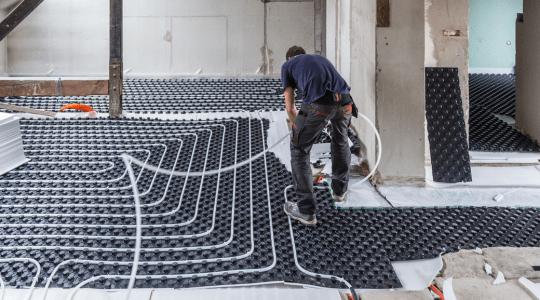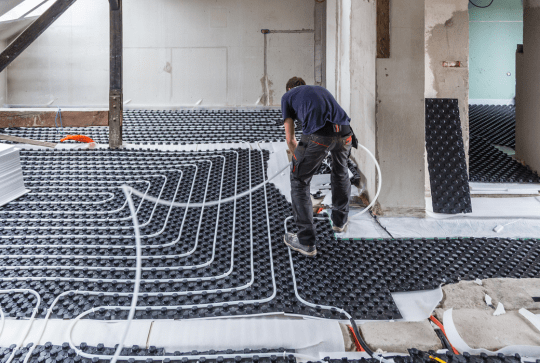23
Aug 2023
Do You Need Overlay Over Underfloor Heating?
Homeowners looking for effective and cosy heating options are increasingly choosing underfloor heating. Underfloor heating has many benefits since it can distribute heat evenly across the floor. One question frequently arises during system installation: “Do you need an overlay for underfloor heating?”
This blog post will examine the advantages and drawbacks of employing an overlay.
Understanding Underfloor Heating
Let’s quickly review the fundamentals of underfloor heating before moving on to the overlay discussion. Under the floor surface, heating elements like electric wires or water pipes are installed as part of this heating system. After that, the heat radiates upward, creating a warm, cosy living area.

Benefits Of Using An Overlay
Improved Heat Distribution
An overlay effectively spreads the heat from the underfloor heating system across the floor surface by acting as a thermal conductor. As a result, heating is more evenly distributed, cold spots are eliminated, and maximum comfort is guaranteed.
Enhanced Durability
An overlay gives the underfloor heating system an extra layer of defence, insulating it from potential harm during installation or regular use. It protects the system as a barrier against pointed items, bulky furniture, or unintentional hits.
Rapid Heat Response
Materials with excellent heat transfer characteristics are frequently used to make overlays. Because
of this, the system can heat up instantly when necessary and fast achieve the desired temperature.
Compatible with a Variety of Flooring Types
Overlays can be utilised with various flooring types, including carpet, engineered wood, laminate, and tiles. They give floor coverings a sturdy surface, guaranteeing proper support and avoiding harm to the heating elements.
Considerations When Choosing an Overlay
Thickness
The overlay’s thickness should be carefully examined to prevent needless height growth. Excessive height could necessitate adjusting doors, skirting boards, or other fixtures. This is especially crucial if the underfloor heating system is retrofitted into an existing area.
Heat Conductivity
Choose an overlay material with high thermal conductivity to maximise heat transfer effectiveness. Due to their outstanding heat distribution qualities, materials like cementitious or gypsum-based overlays are frequently employed.
Insulation
Take into account the overlay’s insulation qualities. A properly insulated overlay raises the system’s energy efficiency and lowers heating expenses by preventing heat from escaping downward.
Even though it is not required for every underfloor heating installation, an overlay has many advantages, including better heat distribution, quicker response times, flooring compatibility, and system protection. Consult pros and experts like JCW Underfloor Heating if you are considering installing underfloor heating in your house or project. They can help you select the best overlay and offer high-quality underfloor heating materials. Call JCW Underfloor Heating right away to experience the effectiveness and comfort of underfloor heating.

Look no further than JCW Underfloor Heating for dependable, high-quality underfloor heating products. JCW is dedicated to offering outstanding customer service and creative solutions catered to your heating needs. They provide a wide selection of heating systems, accessories, and expert knowledge. JCW has a large assortment of underfloor heating supplies to meet any project requirements, whether you’re a homeowner, contractor, or specifier.
